High-definition macro to micro confocal imaging
The AZ-C2+ enables high-definition confocal imaging during macro observation as well as micro observation.
Sharp wide field of view images with unprecedentedly high S/N ratios allow for imaging of whole-mount specimens such as embryos and large tissue slices that are commonly used in developmental and systems biology studies.
Moreover, the AZ-C2+ offers a combination of low and high magnification objective lenses and a scanning zoom function, enabling continuous imaging from macro to micro with a single microscope.
The macro in vivo imaging capabilities allow for the capture of confocal images that were previously not possible with traditional stereoscopic microscopes.

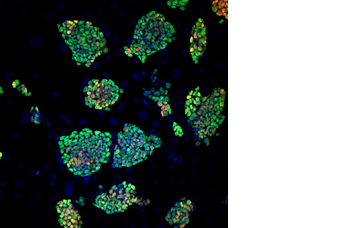
TT2 ES cells
Anti-Nanog antibody (Cy3), anti-Oct3/4 antibody (Alexa488) and DAPI localized in cell nuclei
Photographed with the cooperation of: Hiroshi Kiyonari, Laboratory for Animal Resources and Genetic Engineering, RIKEN Center for Developmental Biology
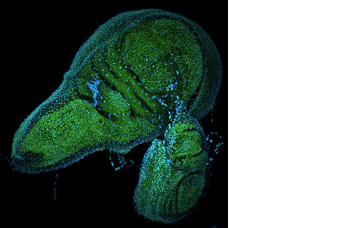
Photo courtesy of: Director and Professor Masatoshi Yamamoto, Drosophila Genetic Resource Center, Kyoto Institute of Technology
Comparison of same specimen regions captured by the AZ-C2+ and an epi-fluorescence microscope
The AZ-C2+ eliminates out-of-focus light and flare to deliver highly resolved confocal fluorescence images and optical sections.

Confocal fluorescence maximum projection image

Standard wide-field fluorescence image
- Specimen: 7.5-day-old mouse embryo expressing H2B-EGFP. (Plan Fluor 2x used)
Photos courtesy of: Dr. Toshihiko Fujimori*1*2, Dr. Go Shioi*2
- *1Division of Embryology, Developmental Biology, National Institute for Basic Biology
- *2Genetic Engineering Unit, Laboratory for Animal Resources and Genetic Engineering, Center for Developmental Biology, RIKEN

Confocal fluorescence maximum projection image

Standard wide-field fluorescence image
- Specimen: Zebrafish eye double-stained with GFP and mCherry
Photos courtesy of: 2008 Physiology Course, Marine Biological Laboratory
One-shot–whole specimen–macro confocal imaging
High NA objectives for macro observation enable fast, high-resolution, single-image capture of a wide specimen area. Because the objectives cover a field of view larger than 1 cm, imaging of embryos during late stages of development and the dynamics of cell populations in whole organs are possible.
- [Note] When Plan Apochromat 1x and AZ100 optical zoom 4x are used, the diagonal diameter of the real field of view is 5.3 mm.

Confocal fluorescence maximum projection image (Plan Fluor 2x used)
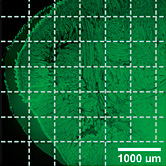
Conventional confocal microscope (stitched image)
The AZ-C2+ can capture wide-field, optical sections at high resolution in a single scan. With a conventional confocal microscope, image stitching is necessary because the field of view that can be captured in a single scan is small.
- Specimen: Rat tongue slice
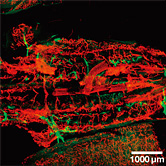
Confocal fluorescence maximum projection image (Plan Apochromat 1x used)
Specimen: Neurons (green) and blood vessels (red) of 6.0-day-old chick embryo

Confocal fluorescence maximum projection image (Plan Apochromat 1x used)
Specimen: Blood vessels (red) of 2.5-day-old chick embryo
- Photos courtesy of: Dr. Yoshiko Takahashi, Molecular and Developmental Biology, Graduate School of Biological Science, NAIST

Confocal fluorescence maximum projection image (macro image, Plan Apochromat 1x used)

Confocal fluorescence maximum projection image (magnified image)
- Specimen: Rabbit hyaline cartilage cells embedded in atelocollagen gel and cultured for 21 days; live cells (green) and type II collagen (red)
- Photos courtesy of: Dr. Masahiro Kino-oka, Laboratory of Bioprocess Systems Engineering, Department of Biotechnology, Division of Advanced Science and Biotechnology, Graduate School of Engineering, Osaka University
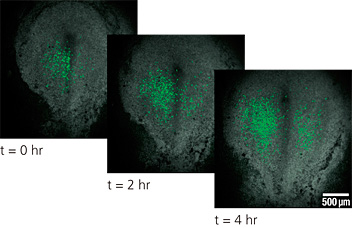
The AZ-C2+ allows time-lapse observation of the dynamic behavior of cell populations.
- Specimen: Chick embryo in stage IV (Plan Fluor 2x used) expressing GAP43-eGFP to label plasma membrane.
- Photos courtesy of: Dr. Yukiko Nakaya, Laboratory for Early Embryogenesis, Center for Developmental Biology, RIKEN
Continuous imaging from low magnification to high magnification
With five different objective lenses, optical zoom and confocal scan zoom, the AZ-C2+ makes imaging possible from very low magnification to high magnification. Macro imaging, such as whole-section imaging, and micro imaging, including imaging of a single cell, can be done using a single microscope.

High magnification imaging offers clear and sharp images of single cells.
- Specimen: Human breast cancer cell line MDA-MB-231 (Plan Fluor 5x used)
Photos courtesy of: Dr. Kazuyuki Itoh, Department of Biology, Osaka Medical Center for Cancer and Cardiovascular Diseases
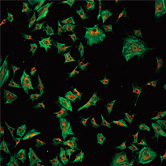
Zoom 1x
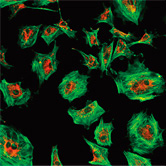
Zoom 2x
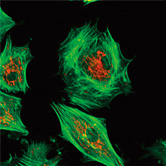
Zoom 4x

Zoom 8x
- Specimen: BPAE cells (Plan Fluor 5x and C1 confocal scan zoom used)
Deep imaging of whole specimens

The AZ-C2+ allows imaging deep into the specimen–difficult to achieve with conventional confocal microscopes. The AZ-C2+ efficiently captures fluorescence signals from deep within a specimen in macro and in-vivo imaging.
Nerve cells (red) 2 mm beneath the surface of the embryo can be imaged clearly.
- Specimen: 2.5-day-old chick embryo
Photo courtesy of: Dr. Yoshiko Takahashi, Molecular and Developmental Biology, Graduate School of Biological Science, NAIST
Confocal laser microscope system C2+/C2si+ Ready/C2si+
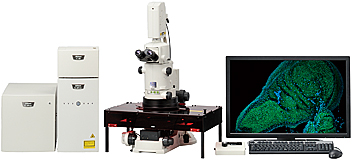
Configuration with spectral confocal system C2si+
The Nikon C2+ series offers the optimum confocal system to meet both your research and your budgetary needs.
C2+: Standard model boasts high resolution, high sensitivity, and high contrast. Suited for single laboratories or large research groups.
C2si+ Ready: Upgrade to C2si+ is possible by adding a spectral detector.
C2si+: Spectral confocal system featuring a 32-ch multianode spectral detector. A spectral bandwidth of 320 nm can be captured in a single scan.
- [Note] Upgrade to the macro confocal microscope system is through a combination of the C2+ series and the AZ100 microscope. The AZ100M and A1+ series are not compatible.
- Sample images captured with AZ-C1
To learn more about these products, please see the C2+ brochure.

